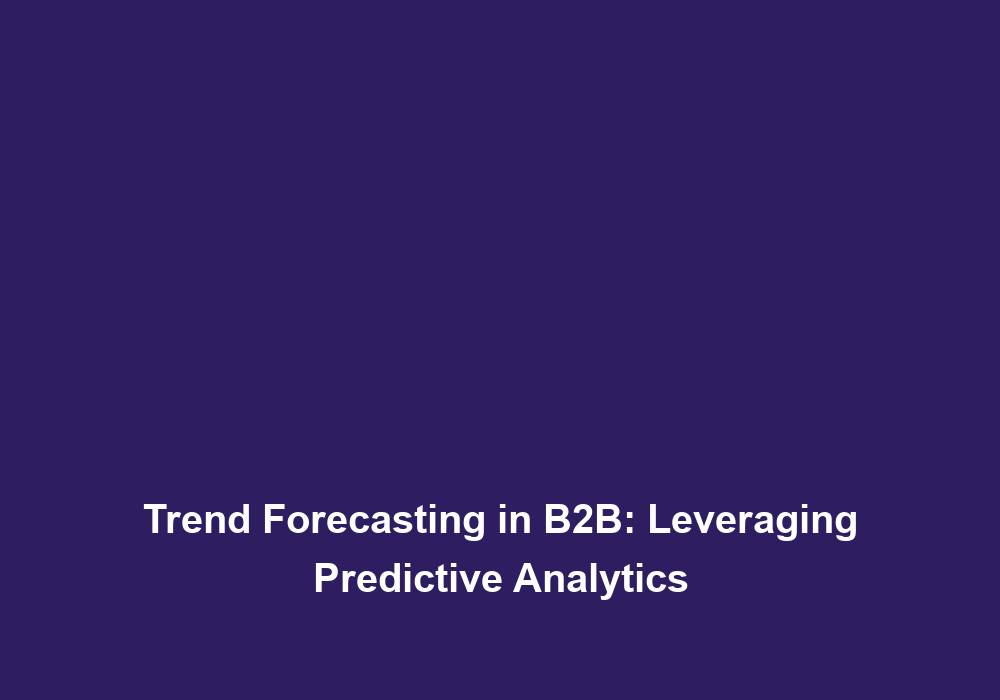In today’s rapidly evolving business landscape, staying ahead of the competition is crucial for any B2B organization. To achieve this, businesses need to make informed decisions based on accurate market insights and predictions. This is where trend forecasting comes into play. By leveraging the power of predictive analytics, businesses can gain a competitive edge by anticipating market trends, customer needs, and industry shifts. In this article, we will explore the concept of trend forecasting in B2B and delve into the importance of leveraging predictive analytics for sustainable success.
The Basics of Trend Forecasting
Trend forecasting involves analyzing historical data, market indicators, consumer behavior, and other relevant factors to predict future trends and patterns. In the B2B context, trend forecasting is particularly valuable as it helps businesses identify emerging opportunities, plan strategic initiatives, and optimize resource allocation. It enables organizations to make proactive decisions instead of reacting to market changes after they have occurred.
Predictive analytics, an integral component of trend forecasting, utilizes various statistical techniques, machine learning algorithms, and data mining to forecast future outcomes with a high degree of accuracy. By drawing insights from both internal and external data sources, predictive analytics empowers B2B organizations to make data-driven decisions, mitigate risks, and seize opportunities.
Importance of Trend Forecasting in B2B
-
Strategic Planning: Trend forecasting enables B2B organizations to align their long-term strategies with anticipated market trends. By identifying upcoming customer demands, technological advancements, and industry shifts, businesses can tailor their product development, marketing campaigns, and overall business strategies to stay ahead.
-
Competitive Advantage: Anticipating trends before competitors do can provide a significant advantage in the B2B space. Trend forecasting allows businesses to differentiate themselves by offering innovative solutions, addressing emerging customer needs, and adapting their operations to changing market dynamics.
-
Risk Mitigation: By understanding the potential risks and challenges associated with upcoming trends, businesses can take proactive measures to mitigate them. Trend forecasting allows organizations to identify potential pitfalls, evaluate alternative scenarios, and prepare contingency plans, minimizing the negative impact of unforeseen events.
-
Resource Optimization: Leveraging predictive analytics for trend forecasting helps B2B organizations optimize resource allocation. By accurately predicting demand patterns, businesses can streamline their supply chain, manage inventory efficiently, and allocate resources strategically, reducing costs and improving operational efficiency.
Leveraging Predictive Analytics for Trend Forecasting
To effectively leverage predictive analytics for trend forecasting in B2B, organizations need to follow a systematic approach:
-
Define Objectives: Clearly define the specific objectives and outcomes you want to achieve through trend forecasting. This could include identifying potential market opportunities, optimizing pricing strategies, or improving customer segmentation.
-
Collect Quality Data: Gather relevant data from both internal and external sources. Internal data may include sales records, customer profiles, and transaction history, while external data can be obtained from industry reports, market research, and social media analytics. Ensure the data collected is accurate, complete, and up-to-date.
-
Data Analysis: Utilize statistical analysis techniques, data mining, and machine learning algorithms to uncover patterns, correlations, and insights within the collected data. This step involves cleaning and transforming the data, applying appropriate analytical models, and interpreting the results.
-
Build Predictive Models: Develop predictive models using the analyzed data to forecast future trends. This may involve employing regression analysis, time series forecasting, clustering, or other advanced techniques depending on the nature of the data and the desired outcomes.
-
Validate and Refine: Validate the accuracy and reliability of the predictive models by comparing the forecasted outcomes with actual results. Continuously refine the models based on new data and emerging trends to improve their predictive capabilities.
-
Implement and Monitor: Implement the insights gained from trend forecasting into your business strategies and operations. Monitor the outcomes, evaluate the effectiveness of the implemented strategies, and make necessary adjustments to further optimize results.
Best Practices for Effective Trend Forecasting
To ensure the effectiveness of trend forecasting efforts, consider the following best practices:
-
Collaboration: Foster collaboration between different departments within the organization, including marketing, sales, finance, and operations. By integrating insights from various functions, you can gain a holistic understanding of trends and make better-informed decisions.
-
Continual Learning: Stay updated with the latest advancements in predictive analytics and data science. Continual learning and skill development are vital to enhance the accuracy and efficiency of trend forecasting models.
-
Benchmarking: Compare your organization’s performance and predictions against industry benchmarks regularly. This helps identify areas for improvement and ensures that your trend forecasting efforts are keeping up with or surpassing industry standards.
-
Monitor Relevant Data Sources: Continuously monitor and analyze relevant data sources, such as social media trends, industry reports, and customer feedback. By staying attuned to external factors, you can identify emerging trends at an early stage and adjust your strategies accordingly.
-
Consider Expert Insights: While data-driven trend forecasting is crucial, don’t overlook the value of expert insights and industry expertise. Combining data analysis with the knowledge and experience of industry professionals can enhance the accuracy and relevance of your predictions.
In conclusion, trend forecasting in B2B, powered by predictive analytics, is an invaluable tool for organizations seeking to gain a competitive edge. By understanding emerging trends, businesses can adapt their strategies, optimize resource allocation, and make proactive decisions that drive sustainable success. By following a systematic approach, leveraging quality data, and implementing best practices, B2B organizations can harness the power of trend forecasting to stay ahead of the curve in an ever-evolving market.
